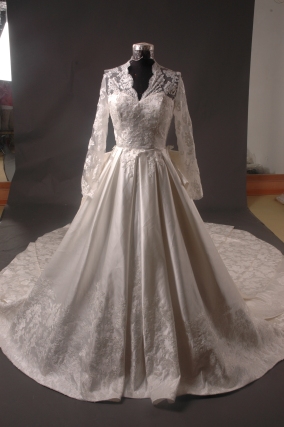My latest blog post from the IMA website is re-posted below!
As someone who did not catch royal wedding fever last year, I was still shocked to learn that a Wikipedia article about Kate Middleton’s wedding dress was flagged for deletion. As Slate.com author Torie Bosch explains in her story, an entry about the significance of Middleton’s wedding dress was deemed inappropriate by many Wikipedia users. Some believed that “this is frankly trivial, and surely isn’t notable enough to be on Wikipedia,” while others complained that this was “exactly the sort of thing that made me all but quit as an active user on this project.”

Replica of Kate Middleton’s Royal Dress. Image by Milly Bridal Studio for MyWeddingDressForLess.co.uk [CC-BY-SA-3.0]
That’s an astonishing low number. Wikipedia states that they would like to increase the percentage of female editors to 25 percent. A leader in this effort and the current Wikimedia Foundation Community Fellow, Sarah Stierch, has organized a couple of “Wikipedia edit-a-thons” where women get together and create new articles about women in history using Smithsonian records.
As I read this article, I tried to think about my relationship with Wikipedia. I have never created or edited an article, yet I use Wikipedia daily. It never occurs to me to add to this great body of knowledge. As a member of the minority on Wikipedia, I feel like it is important to get involved in this process.
Now, let me try to bring this around to art conservation and the museum profession in general.
Though it’s documented that women do not contribute to Wikipedia, it’s hard to know how many female art conservators are contributing – I’m guessing maybe one or two, if any. Anecdotally, I know that most art conservators are female, and that the membership of American Institute for Conservation (AIC) is greater than 3,000 so this seems like a good base to look to for contributors.
I should also point out that AIC created its own wiki site that has some good information in it, but the information in there is not easily found by search engines.
While the AIC Wiki could be useful, I’d like to suggest that art conservators start adding their knowledge directly to Wikipedia. I think we’ll all agree that it is much more reliable than it used to be. Imagine if as a profession we added our knowledge to Wikipedia, how much we could help improve the readily-available information about caring for collections (and we’d be making a significant dent in the gender gap along the way)!
For a profession that is as relatively obscure as ours, and one dedicated to preserving our cultural heritage, it’s important to make our knowledge as accessible as possible, and a crucial way of accomplishing this is to contribute to Wikipedia articles on conservation.
One way to do this is to start documenting discreet collections of artworks by individual artists. For example, what if we had Wikipedia articles about every Van Gogh ever painted, that included correct information about all of the pigments he used, and the different kinds of canvases or supports he painted. That would be useful and interesting for conservators and art lovers alike. Or, we could do all of the pieces by Judy Chicago, or Louise Bourgeois.
INCCA-NA has taken this idea and started the Artist Research Project. Their first artist is Tony Smith, whose 100th birthday is in September of this year. Smith is well-known for creating large-scale outdoor sculptures around the world. This project was recently mentioned in the New York Times “Arts Beat”.
To participate in this project, follow these seven easy steps:- Find the Tony Smith sculpture closest to you.
- Research it.
- Document it by creating a Wikipedia article about your artwork.
- Take pictures of it.
- Upload those pictures to Flickr.
- Add those pictures to the Tony Smith Flickr group.
- Tell people what you did!
For more detailed information about the project, follow this link.
I see this as a kind of first effort, almost an experiment, to see if conservators and others that care about artwork can work together to create knowledge about a discreet collection. In the end, I think the sum of knowledge could be incredibly useful for conservators. It would be beneficial to know all of the paint systems he used, the exhibition history of the artworks, and images of what the pieces look like right now.
By contributing to Wikipedia articles on conservation, we can address both these issues at once: we can help bring attention to our discipline by coming to information seekers rather than requiring them to come to us, and, as a profession made up primarily of women (male conservators are welcome, too, of course!), we can help to address the gender gap on Wikipedia.








